Trace Metals in Rice Grains and Their Associated Health Risks from Conventional and Non-Conventional Rice Growing Areas in Punjab-Pakistan
Abstract
1. Introduction
2. Materials and Methods
2.1. Sampling
2.2. Sample Preparation and Analysis
2.3. Quality Control
2.4. Health Risk Assessment
2.5. Statistical Analysis
3. Results
3.1. Trace Metal Concentration in Rice Grains from Non-Conventional Growing Areas
3.1.1. Essential Metals
3.1.2. Non-Essential Metals
3.2. Trace Metal Concentration in Rice Grains from Conventional Rice Growing Areas
3.2.1. Essential Metals
3.2.2. Non-Essential Metals
3.3. Relation between the Toxic Metals
3.4. Principal Component Analysis and Heatmap
4. Discussion
4.1. Sources of Metals in Rice Growing Areas of Pakistan
4.2. Non-Essential Metals in Rice
4.3. Essential Metals in Rice
4.4. Health Risk Assessment
5. Conclusions
Supplementary Materials
Author Contributions
Funding
Institutional Review Board Statement
Informed Consent Statement
Data Availability Statement
Acknowledgments
Conflicts of Interest
References
- Mehmood, A.; Mirza, M.A.; Choudhary, M.A.; Kim, K.-H.; Raza, W.; Raza, N.; Lee, S.S.; Zhang, M.; Lee, J.-H.; Sarfraz, M. Spatial distribution of heavy metals in crops in a wastewater irrigated zone and health risk assessment. Environ. Res. 2019, 168, 382–388. [Google Scholar] [CrossRef]
- Nzediegwu, C.; Prasher, S.; Elsayed, E.; Dhiman, J.; Mawof, A.; Patel, R. Effect of biochar on heavy metal accumulation in potatoes from wastewater irrigation. J. Environ. Manag. 2019, 232, 153–164. [Google Scholar] [CrossRef] [PubMed]
- Onakpa, M.M.; Njan, A.A.; Kalu, O.C. A review of heavy metal contamination of food crops in Nigeria. Ann. Glob. Health 2018, 84, 488. [Google Scholar] [CrossRef] [PubMed]
- Sharma, S.; Nagpal, A.K.; Kaur, I. Heavy metal contamination in soil, food crops and associated health risks for residents of Ropar wetland, Punjab, India and its environs. Food Chem. 2018, 255, 15–22. [Google Scholar] [CrossRef] [PubMed]
- Sarim, M.; Jan, T.; Khattak, S.A.; Mihoub, A.; Jamal, A.; Saeed, M.F.; Soltani-Gerdefaramarzi, S.; Tariq, S.R.; Fernández, M.P.; Mancinelli, R. Assessment of the Ecological and Health Risks of Potentially Toxic Metals in Agricultural Soils from the Drosh-Shishi Valley, Pakistan. Land 2022, 11, 1663. [Google Scholar] [CrossRef]
- Ikram, M.; Ali, N.; Jan, G.; Jan, F.G.; Rahman, I.U.; Iqbal, A.; Hamayun, M. IAA producing fungal endophyte Penicillium roqueforti Thom., enhances stress tolerance and nutrients uptake in wheat plants grown on heavy metal contaminated soils. PLoS ONE 2018, 13, e0208150. [Google Scholar] [CrossRef]
- Zhu, H.; Teng, Y.; Wang, X.; Zhao, L.; Ren, W.; Luo, Y.; Christie, P. Changes in clover rhizosphere microbial community and diazotrophs in mercury-contaminated soils. Sci. Total Environ. 2021, 767, 145473. [Google Scholar] [CrossRef] [PubMed]
- Shilev, S.; Babrikova, I.; Babrikov, T. Consortium of plant growth—Promoting bacteria improves spinach (Spinacea oleracea L.) growth under heavy metal stress conditions. J. Chem. Technol. Biotechnol. 2020, 95, 932–939. [Google Scholar] [CrossRef]
- Xiao, R.; Wang, S.; Li, R.; Wang, J.J.; Zhang, Z. Soil heavy metal contamination and health risks associated with artisanal gold mining in Tongguan, Shaanxi, China. Ecotoxicol. Environ. Saf. 2017, 141, 17–24. [Google Scholar] [CrossRef]
- Adimalla, N.; Chen, J.; Qian, H. Spatial characteristics of heavy metal contamination and potential human health risk assessment of urban soils: A case study from an urban region of South India. Ecotoxicol. Environ. Saf. 2020, 194, 110406. [Google Scholar] [CrossRef]
- Mishra, S.; Bharagava, R.N.; More, N.; Yadav, A.; Zainith, S.; Mani, S.; Chowdhary, P. Heavy metal contamination: An alarming threat to environment and human health. In Environmental Biotechnology: For Sustainable Future; Sobti, R., Arora, N., Kothari, R., Eds.; Springer: Singapore, 2019; pp. 103–125. [Google Scholar]
- Du, F.; Yang, Z.; Liu, P.; Wang, L. Accumulation, translocation, and assessment of heavy metals in the soil-rice systems near a mine-impacted region. Environ. Sci. Pollut. Res. 2018, 25, 32221–32230. [Google Scholar] [CrossRef] [PubMed]
- Wang, Z.; Qin, H.; Liu, X. Health risk assessment of heavy metals in the soil-water-rice system around the Xiazhuang uranium mine, China. Environ. Sci. Pollut. Res. 2019, 26, 5904–5912. [Google Scholar] [CrossRef]
- Fan, Y.; Zhu, T.; Li, M.; He, J.; Huang, R. Heavy metal contamination in soil and brown rice and human health risk assessment near three mining areas in central China. J. Health Eng. 2017, 2017, 4124302. [Google Scholar] [CrossRef] [PubMed]
- Barau, B.; Abdulhameed, A.; Ezra, A.; Muhammad, M.; Kyari, E.; Bawa, U. Heavy metal contamination of some vegetables from pesticides and the potential health risk in Bauchi, northern Nigeria. Int. J. Sci. Technol. 2018, 7, 1–11. [Google Scholar] [CrossRef]
- Tian, D.; Li, Z.; O’Connor, D.; Shen, Z. The need to prioritize sustainable phosphate—Based fertilizers. Soil Use Manag. 2020, 36, 351–354. [Google Scholar] [CrossRef]
- Kahil, A.; Hassan, F.; Ali, E. Influence of bio-fertilizers on growth, yield and anthocyanin content of Hibiscus sabdariffa L. plant under Taif region conditions. Annu. Res. Rev. Biol. 2017, 17, 1–15. [Google Scholar] [CrossRef]
- Hassan, F.; Ali, E.; Mahfouz, S. Comparison between different fertilization sources, irrigation frequency and their combinations on the growth and yield of coriander plant. Aust. J. Basic. Appl. Sci. 2012, 6, 600–615. [Google Scholar]
- Saboor, A.; Ali, M.A.; Ahmed, N.; Skalicky, M.; Danish, S.; Fahad, S.; Hassan, F.; Hassan, M.M.; Brestic, M.; El Sabagh, A. Biofertilizer-based zinc application enhances maize growth, gas exchange attributes, and yield in zinc-deficient soil. Agriculture 2021, 11, 310. [Google Scholar] [CrossRef]
- Wagh, V.M.; Panaskar, D.B.; Mukate, S.V.; Gaikwad, S.K.; Muley, A.A.; Varade, A.M. Health risk assessment of heavy metal contamination in groundwater of Kadava River Basin, Nashik, India. Model Earth Syst. Environ. 2018, 4, 969–980. [Google Scholar] [CrossRef]
- Chiamsathit, C.; Auttamana, S.; Thammarakcharoen, S. Heavy metal pollution index for assessment of seasonal groundwater supply quality in hillside area, Kalasin, Thailand. Appl. Water Sci. 2020, 10, 1–8. [Google Scholar] [CrossRef]
- Jalees, M.I.; Farooq, M.U.; Anis, M.; Hussain, G.; Iqbal, A.; Saleem, S. Hydrochemistry modelling: Evaluation of groundwater quality deterioration due to anthropogenic activities in Lahore, Pakistan. Environ. Dev. Sustain. 2021, 23, 3062–3076. [Google Scholar] [CrossRef]
- Qiao, J.; Zhu, Y.; Jia, X.; Niu, X.; Liu, J. Distributions of arsenic and other heavy metals, and health risk assessments for groundwater in the Guanzhong Plain region of China. Environ. Res. 2020, 181, 108957. [Google Scholar] [CrossRef] [PubMed]
- Pateriya, A.; Verma, R.K.; Sankhla, M.S.; Kumar, R. Heavy metal toxicity in rice and its effects on human health. Lett. Appl. NanoBio. Sci. 2020, 10, 1833–1845. [Google Scholar]
- Sultana, M.S.; Rana, S.; Yamazaki, S.; Aono, T.; Yoshida, S. Health risk assessment for carcinogenic and non-carcinogenic heavy metal exposures from vegetables and fruits of Bangladesh. Cogent Environ. Sci. 2017, 3, 1291107. [Google Scholar] [CrossRef]
- Bi, C.; Zhou, Y.; Chen, Z.; Jia, J.; Bao, X. Heavy metals and lead isotopes in soils, road dust and leafy vegetables and health risks via vegetable consumption in the industrial areas of Shanghai, China. Sci. Total Environ. 2018, 619, 1349–1357. [Google Scholar] [CrossRef]
- Rehman, Z.U.; Sardar, K.; Shah, M.T.; Brusseau, M.L.; Khan, S.A.; Mainhagu, J. Transfer of heavy metals from soils to vegetables and associated human health risks at selected sites in Pakistan. Pedosphere 2018, 28, 666–679. [Google Scholar] [CrossRef]
- Gupta, N.; Yadav, K.K.; Kumar, V.; Krishnan, S.; Kumar, S.; Nejad, Z.D.; Khan, M.M.; Alam, J. Evaluating heavy metals contamination in soil and vegetables in the region of North India: Levels, transfer and potential human health risk analysis. Environ. Toxicol. Pharm. 2021, 82, 103563. [Google Scholar] [CrossRef]
- Wasim, A.A.; Naz, S.; Khan, M.N.; Fazalurrehman, S. Assessment of heavy metals in rice using atomic absorption spectrophotometry–A study of different rice varieties in Pakistan. Pak. J. Anal. Environ. 2019, 20, 67–74. [Google Scholar] [CrossRef]
- Huang, B.; Li, Z.; Li, D.; Yuan, Z.; Chen, Z.; Huang, J. Distribution characteristics of heavy metal (loid) s in aggregates of different size fractions along contaminated paddy soil profile. Environ. Sci. Pollut. Res. 2017, 24, 23939–23952. [Google Scholar] [CrossRef]
- Onsanit, S.; Ke, C.; Wang, X.; Wang, K.-J.; Wang, W.-X. Trace elements in two marine fish cultured in fish cages in Fujian province, China. Environ. Pollut. 2010, 158, 1334–1342. [Google Scholar] [CrossRef]
- Food and Agriculture Organization of the United Nations (FAO); World Health Organization (WHO). Principles and Methods for the Risk Assessment of Chemicals in Food; Chapter 6 Dietary Exposure Assessment of Chemicals in Food; FAO: Rome, Italy; WHO: Geneva, Switzerland, 2009; Volume 68. [Google Scholar]
- Khan, A.Z.; Khan, S.; Khan, M.A.; Alam, M.; Ayaz, T. Biochar reduced the uptake of toxic heavy metals and their associated health risk via rice (Oryza sativa L.) grown in Cr-Mn mine contaminated soils. Environ. Technol. Innov. 2020, 17, 100590. [Google Scholar] [CrossRef]
- Tran, L.D.; Phung, L.D.; Pham, D.V.; Pham, D.D.; Nishiyama, M.; Sasaki, A.; Watanabe, T. High yield and nutritional quality of rice for animal feed achieved by continuous irrigation with treated municipal wastewater. Paddy Water Environ. 2019, 17, 507–513. [Google Scholar] [CrossRef]
- Hussain, A.; Alamzeb, S.; Begum, S. Accumulation of heavy metals in edible parts of vegetables irrigated with waste water and their daily intake to adults and children, District Mardan, Pakistan. Food Chem. 2013, 136, 1515–1523. [Google Scholar]
- Karim, Z.; Qureshi, B.A. Health risk assessment of heavy metals in urban soil of Karachi, Pakistan. Hum. Ecol. Risk Assess 2014, 20, 658–667. [Google Scholar] [CrossRef]
- Mahmood, A.; Malik, R.N. Human health risk assessment of heavy metals via consumption of contaminated vegetables collected from different irrigation sources in Lahore, Pakistan. Arab. J. Chem. 2014, 7, 91–99. [Google Scholar] [CrossRef]
- Ullah, H.; Noreen, S.; Rehman, A.; Waseem, A.; Zubair, S.; Adnan, M.; Ahmad, I. Comparative study of heavy metals content in cosmetic products of different countries marketed in Khyber Pakhtunkhwa, Pakistan. Arab. J. Chem. 2017, 10, 10–18. [Google Scholar] [CrossRef]
- Nawaz, A.; Khurshid, K.; Arif, M.S.; Ranjha, A. Accumulation of heavy metals in soil and rice plant (Oryza sativa L.) irrigated with industrial effluents. Int. J. Agric. Biol. 2006, 8, 391–393. [Google Scholar]
- Azam, I.; Afsheen, S.; Zia, A.; Javed, M.; Saeed, R.; Sarwar, M.K.; Munir, B. Evaluating insects as bioindicators of heavy metal contamination and accumulation near industrial area of Gujrat, Pakistan. Biomed. Res. Int. 2015, 2015, 942751. [Google Scholar] [CrossRef]
- Qi, D.; Yan, J.; Zhu, J. Effect of a reduced fertilizer rate on the water quality of paddy fields and rice yields under fishpond effluent irrigation. Agric. Water Manag. 2020, 231, 105999. [Google Scholar] [CrossRef]
- Khan, K.; Lu, Y.; Khan, H.; Ishtiaq, M.; Khan, S.; Waqas, M.; Wei, L.; Wang, T. Heavy metals in agricultural soils and crops and their health risks in Swat District, northern Pakistan. Food Chem. Toxicol. 2013, 58, 449–458. [Google Scholar] [CrossRef] [PubMed]
- Tariq, S.R.; Shafiq, M.; Chotana, G.A. Distribution of heavy metals in the soils associated with the commonly used pesticides in cotton fields. Scientifica 2016, 2016, 7575239. [Google Scholar] [CrossRef] [PubMed]
- Park, H.J.; Kim, S.U.; Jung, K.Y.; Lee, S.; Choi, Y.D.; Owens, V.N.; Kumar, S.; Yun, S.W.; Hong, C.O. Cadmium phytoavailability from 1976 through 2016: Changes in soil amended with phosphate fertilizer and compost. Sci. Total Environ. 2021, 762, 143132. [Google Scholar] [CrossRef] [PubMed]
- Murtaza, G.; Javed, W.; Hussain, A.; Wahid, A.; Murtaza, B.; Owens, G. Metal uptake via phosphate fertilizer and city sewage in cereal and legume crops in Pakistan. Environ. Sci. Pollut. Res. 2015, 22, 9136–9147. [Google Scholar] [CrossRef]
- Jho, E.H.; Youn, Y.; Yun, S.H. Effect of CO2 exposure on the mobility of heavy metals in submerged soils. Appl. Biol. Chem. 2018, 61, 617–623. [Google Scholar] [CrossRef]
- Wan, Y.; Huang, Q.; Camara, A.Y.; Wang, Q.; Li, H. Water management impacts on the solubility of Cd, Pb, As, and Cr and their uptake by rice in two contaminated paddy soils. Chemosphere 2019, 228, 360–369. [Google Scholar] [CrossRef] [PubMed]
- Dennis, K.K.; Judd, S.E.; Alvarez, J.A.; Kahe, K.; Jones, D.P.; Hartman, T.J. Plant food intake is associated with lower cadmium body burden in middle-aged adults. Eur. J. Nutr. 2021, 60, 3365–3374. [Google Scholar] [CrossRef]
- Li, N.; Feng, A.; Liu, N.; Jiang, Z.; Wei, S. Silicon application improved the yield and nutritional quality while reduced cadmium concentration in rice. Environ. Sci. Pollut. Res. 2020, 27, 20370–20379. [Google Scholar] [CrossRef]
- Dehghani, M.; Mosaferi, F. Determination of heavy metals (cadmium, arsenic and lead) in Iranian, Pakistani and Indian rice consumed in Hormozgan Province, Iran. J. Maz. Univ. Med. 2016, 25, 363–367. [Google Scholar]
- Tariq, S.R.; Rashid, N. Multivariate analysis of metal levels in paddy soil, rice plants, and rice grains: A case study from Shakargarh, Pakistan. J. Chem. 2013, 2013, 539251. [Google Scholar] [CrossRef]
- Flood Map Pro. Pakistan Flood Map: Elevation Map, Sea Level Rise Map. 2020. Available online: https://www.floodmap.net/?ct=PK (accessed on 18 August 2021).
- World Bank. Population, Total-Pakistan. 2021. Data. Available online: https://data.worldbank.org/indicator/SP.POP.TOTL?end=2020&locations=PK&start=1960&view=chart (accessed on 5 August 2022).
- Zeng, F.; Wei, W.; Li, M.; Huang, R.; Yang, F.; Duan, Y. Heavy metal contamination in rice-producing soils of Hunan province, China and potential health risks. Int. J. Environ. Res. 2015, 12, 15584–15593. [Google Scholar] [CrossRef]
- Xu, J.; Yang, L.; Wang, Z.; Dong, G.; Huang, J.; Wang, Y. Toxicity of copper on rice growth and accumulation of copper in rice grain in copper contaminated soil. Chemosphere 2006, 62, 602–607. [Google Scholar] [CrossRef] [PubMed]
- Roychowdhury, T. Impact of sedimentary arsenic through irrigated groundwater on soil, plant, crops and human continuum from Bengal delta: Special reference to raw and cooked rice. Food Chem. Toxicol. 2008, 46, 2856–2864. [Google Scholar] [CrossRef] [PubMed]
- Naseri, M.; Vazirzadeh, A.; Kazemi, R.; Zaheri, F. Concentration of some heavy metals in rice types available in Shiraz market and human health risk assessment. Food Chem. 2015, 175, 243–248. [Google Scholar] [CrossRef] [PubMed]
- Ghoreishy, F.; Salehi, M.; Fallahzade, J. Cadmium and lead in rice grains and wheat breads in Isfahan (Iran) and human health risk assessment. Hum. Ecol. Risk Assess 2019, 25, 924–934. [Google Scholar] [CrossRef]
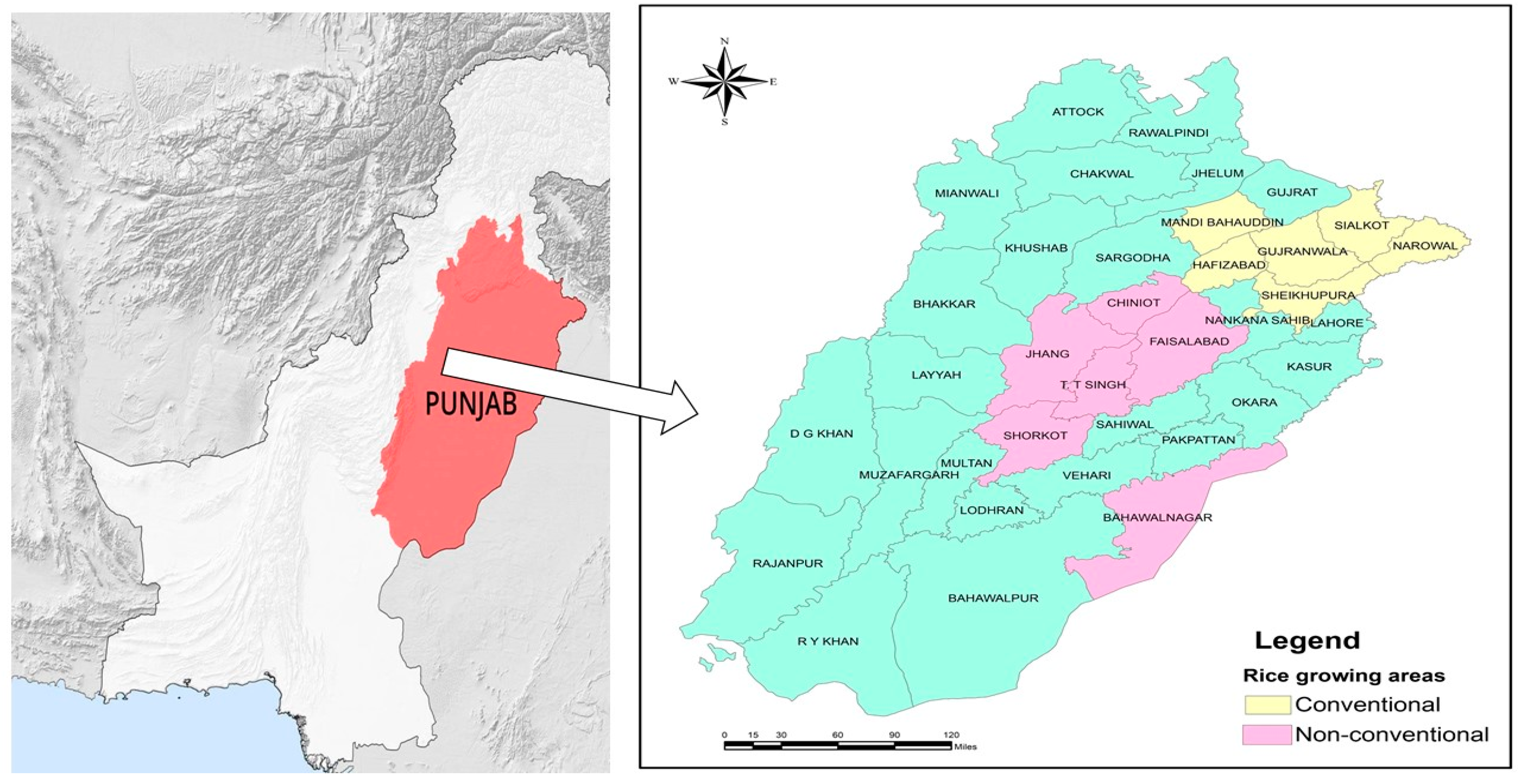
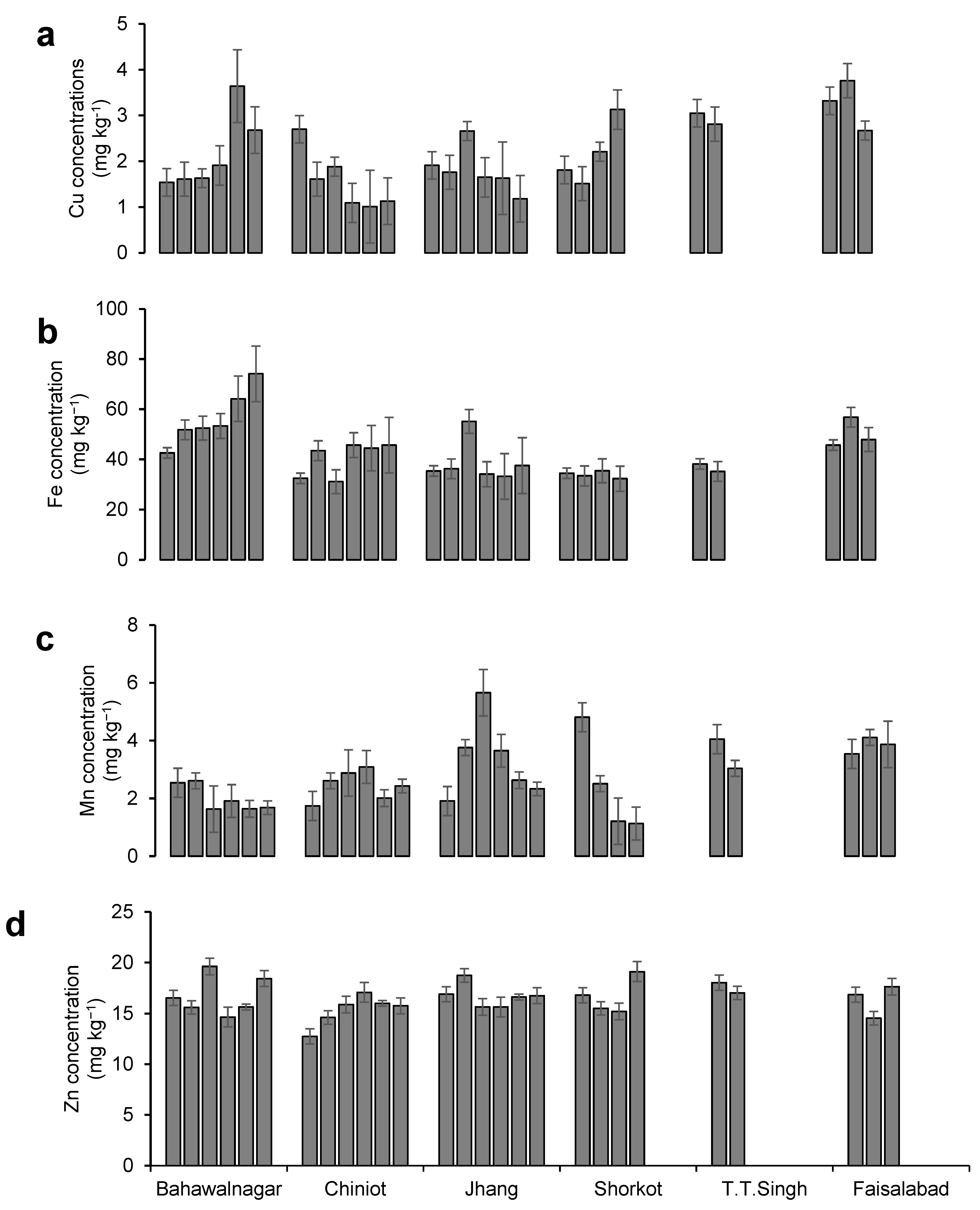
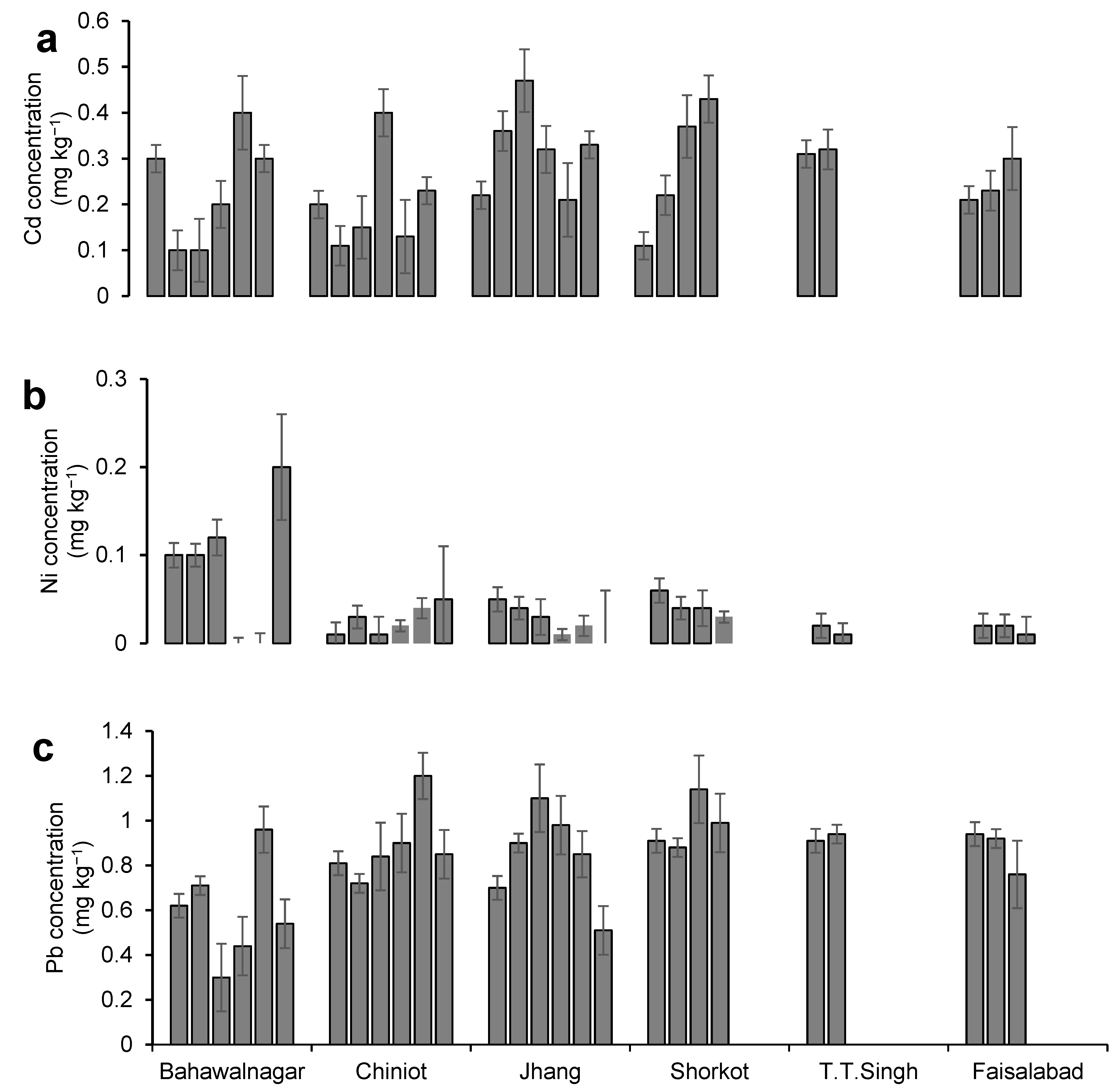
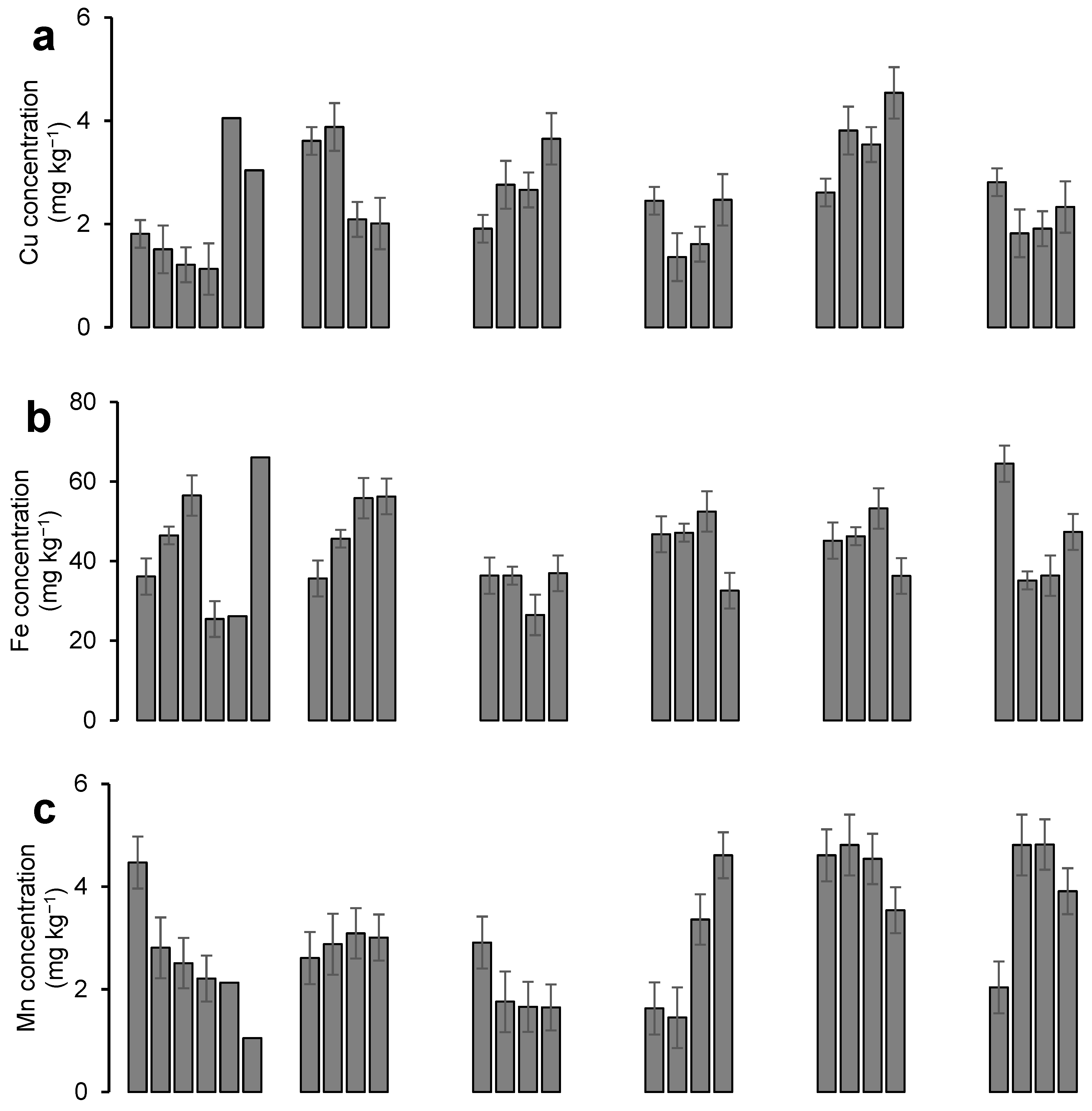



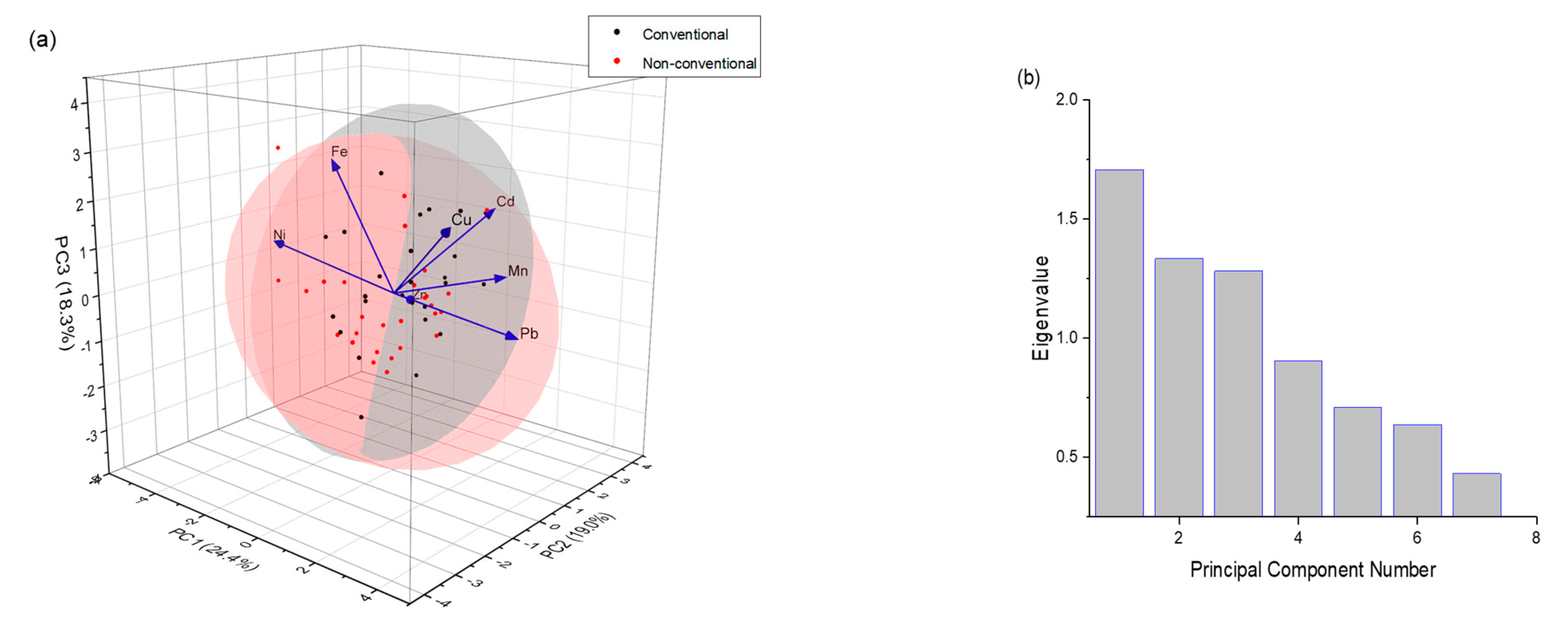

| Sr. No. | Sampling Location | Longitude | Latitude |
|---|---|---|---|
| 1 | Chiniot | 31.710762 | 72.992123 |
| 2 | Bahawalnagar | 29.613738 | 73.137526 |
| 3 | Jhang | 30.843993 | 71.850886 |
| 4 | Shorkot | 30.844500 | 72.085357 |
| 5 | Toba Tek Singh | 30.970966 | 72.479624 |
| 6 | Faisalabad | 31.413924 | 73.074134 |
| 7 | Narowal | 32.096795 | 74.862740 |
| 8 | Gujranwala, | 31.982594 | 74.130777 |
| 9 | Mandi Bahauddin | 32.597835 | 73.476281 |
| 10 | Hafizabad | 32.052014 | 73.659907 |
| 11 | Sialkot | 32.386376 | 74.408410 |
| 12 | Sheikhupura | 31.715192 | 73.982211 |
| Metals | Minimum Value | Maximum Value | Limits (mg kg−1) | References | ||
|---|---|---|---|---|---|---|
| CA * | NCA ** | CA * | NCA ** | |||
| Cd | 0 | 0.10 | 0.54 | 0.47 | 0.2 | WHO/FAO [29] |
| Pb | 0.12 | 0.30 | 1.10 | 1.20 | 0.2 | |
| Ni | 0 | 0.01 | 0.05 | 0.20 | 1.0 | |
| Fe | 25.43 | 31.11 | 66.01 | 74.11 | 15–50 | |
| Cu | 1.13 | 1.01 | 4.54 | 3.76 | 4–15 | |
| Zn | 12.61 | 12.74 | 21.51 | 19.63 | 20 | |
| Mn | 1.05 | 1.13 | 4.82 | 5.66 | 05 | |
| Rice Growing Area | Estimated Weekly Intakes (EWI) | ||||||
|---|---|---|---|---|---|---|---|
| Essential Metals | Non-Essential Metals | ||||||
| Cu | Fe | Mn | Zn | Cd | Ni | Pb | |
| Non-conventional | 18.27 | 360.25 | 27.51 | 95.42 | 2.28 | 0.97 | 5.83 |
| Conventional | 22 | 321 | 23.43 | 105 | 2.65 | 0.24 | 5.34 |
| EWI by WHO | 70 * | 315 * | 77 * | 280 * | 7 | 35 | 25 |
| Metals | Essential Metals | Non-Essential Metals | |||||
|---|---|---|---|---|---|---|---|
| Cu | Fe | Mn | Zn | Cd | Ni | Pb | |
| Metal concentrations in rice grains from non-conventional growing areas | |||||||
| Cu | 1.00 | ||||||
| Fe | 0.30 | 1.00 | |||||
| Mn | 0.14 | −0.02 | 1.00 | ||||
| Zn | 0.00 | 0.05 | 0.00 | 1.00 | |||
| Cd | 0.34 * | 0.08 | 0.11 | 0.22 ** | 1.00 | ||
| Ni | −0.15 | 0.47 * | −0.22 | 0.40 * | −0.21 | 1.00 | |
| Pb | 0.23 | −0.28 | 0.30 | −0.21 | 0.35 * | −0.42 | 1.00 |
| Metal concentrations in rice grains from conventional growing areas | |||||||
| Cu | 1.00 | ||||||
| Fe | −0.10 | 1.00 | |||||
| Mn | −0.01 | −0.11 | 1.00 | ||||
| Zn | −0.42 | −0.20 | 0.14 ** | 1.00 | |||
| Cd | −0.11 | 0.27 * | 0.23 * | 0.18 * | 1.00 | ||
| Ni | −0.18 | −0.02 | −0.10 | 0.09 | 0.30 * | 1.00 | |
| Pb | 0.01 | −0.03 | −0.19 | 0.12 | −0.03 | −0.38 | 1.00 |
Disclaimer/Publisher’s Note: The statements, opinions and data contained in all publications are solely those of the individual author(s) and contributor(s) and not of MDPI and/or the editor(s). MDPI and/or the editor(s) disclaim responsibility for any injury to people or property resulting from any ideas, methods, instructions or products referred to in the content. |
© 2023 by the authors. Licensee MDPI, Basel, Switzerland. This article is an open access article distributed under the terms and conditions of the Creative Commons Attribution (CC BY) license (https://creativecommons.org/licenses/by/4.0/).
Share and Cite
Zeeshan, N.; Farooqi, Z.U.R.; Ahmad, I.; Murtaza, G.; Jamal, A.; Saifullah; Abdul Qadir, A.; Radicetti, E. Trace Metals in Rice Grains and Their Associated Health Risks from Conventional and Non-Conventional Rice Growing Areas in Punjab-Pakistan. Sustainability 2023, 15, 7259. https://doi.org/10.3390/su15097259
Zeeshan N, Farooqi ZUR, Ahmad I, Murtaza G, Jamal A, Saifullah, Abdul Qadir A, Radicetti E. Trace Metals in Rice Grains and Their Associated Health Risks from Conventional and Non-Conventional Rice Growing Areas in Punjab-Pakistan. Sustainability. 2023; 15(9):7259. https://doi.org/10.3390/su15097259
Chicago/Turabian StyleZeeshan, Nukshab, Zia Ur Rahman Farooqi, Iftikhar Ahmad, Ghulam Murtaza, Aftab Jamal, Saifullah, Ayesha Abdul Qadir, and Emanuele Radicetti. 2023. "Trace Metals in Rice Grains and Their Associated Health Risks from Conventional and Non-Conventional Rice Growing Areas in Punjab-Pakistan" Sustainability 15, no. 9: 7259. https://doi.org/10.3390/su15097259
APA StyleZeeshan, N., Farooqi, Z. U. R., Ahmad, I., Murtaza, G., Jamal, A., Saifullah, Abdul Qadir, A., & Radicetti, E. (2023). Trace Metals in Rice Grains and Their Associated Health Risks from Conventional and Non-Conventional Rice Growing Areas in Punjab-Pakistan. Sustainability, 15(9), 7259. https://doi.org/10.3390/su15097259










